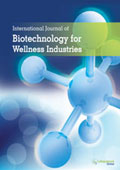ijbwi
Abstract : Generation of New Hybridoma UTM-Ha Secreting Monoclonal Antibody Specific to Acanthamoeba species Isolated from Corneal Infection
|
|
Abstract: Acanthamoeba Keratitis is an important corneal infection that caused impaired vision. The Universiti Malaysia Terengganu (UMT) researcher found new species of Acanthamoeba that was being isolated from eye infection in Hospital Kuala Lumpur, which have the characteristic between Acanthamoeba polyphaga and A. castellanii named as HKL-Acantha. This study was aimed to generate specific monoclonal antibody against HKL-Acantha that eventually could be used in diagnosing eye infection among Malaysian.Two Balb/c mice were immunized with sonicated HKL-Acantha through intraperitoneal injection, and anti HKL-acantha IgG, IgM, IgA were measured using ELISA test. Sera from infected mice showed detectable anti-HKL-acantha IgM. The spleen from animal with high antibody titer around (1:81000) was used as a partner in fusion with SP2/0-Ag14 myeloma cells to produce new hybridoma cells, which were then selected and cloned using the selection medium. Two positive hybridoma clones secreting IgM antibodies were obtained and named as hybridoma UTM-Ha1 and UTM-Ha2. Both clones were secreting monoclonal IgM antibody specific to HKL-Acantha. This study suggests the potential of both hybridomas UTM-Ha1 and UTM-Ha2 to generate specific monoclonal IgM against HKL-acantha. This newly generated monoclonal IgM could be used to diagnose the presence of HKL- acantha in patients with eye infection in future. Keywords: Acanthameoba, corneal infection, HKL-Acantha, UTM-Ha1, UTM-Ha2.Download Full Article |
Abstract : Antiulcerogenic, Anti-Secretory and Cytoprotective Effects of Piper Cubeba (L.) on Experimental Ulcer Models in Rat
|
|
Abstract: This paper evaluated anti-gastric ulcer and anti-secretory effects of a popular spice Piper cubeba L, (Family: Piperaceae) in rats. The gastric ulcer protective potential of an aqueous suspension of Piper cubeba (PCS) was evaluated against different acute gastric ulcer models in rats induced by pyloric ligation (Shay), hypothermic restraint stress, indomethacin and by necrotizing agents (80% ethanol, 0.2 M NaOH and 25% NaCl) induced gastric mucosal injury. Piper cubeba aqueous suspension (PCS) at the doses 250 and 500 mg/kg body weight administered orally (intraperitoneally in Shay rat model) showed a dose-dependent ulcer protective effects in all the above models. Besides, the PCS offered protection against ethanol-induced depletion of gastric wall mucus (GWM); replenished the reduced non-protein sulfhydryls (NP‑SH) concentration and significantly replenished malondialdehyde (MDA) contents in the gastric tissue. Ethanol induced histopathological lesions of the stomach wall characterized by mucosal hemorrhages and edema was reversed by Piper cubeba aqueous suspension treatment. Pretreatment of rats with Piper cubeba provided significant protection of gastric mucosa through its antioxidant capacity and/or by attenuating the offensive and by enhancing the defensive factor. Keywords: Piper cubeba, Arab Traditional Medicine, antiulcerogenic, antisecretagogue, cytoprotective, oxidative stress.Download Full Article |
Abstract : World’s Agricultural Production and Trade: Food Security at Stake?
|
|
Abstract: The extraordinary events of the last couple of years, like the surge and the topsy-turvy movement in oil, raw material and food prices, or the development of a so far unprecedented global financial and economic crisis, have been heavily testing the endurance of those earning their living from agriculture and related activities. All these troubles have not been beneficial to the ongoing trade liberalization process within the framework of WTO. Answers to the challenges at national level and the continuing proliferation of inter- and intraregional free trade agreements make the early global liberalization even less probable. The situation is further complicated by those really divergent changes of agricultural policy that are about to develop on the opposite sides of the Atlantic. In this paper, we describe the recent development of world’s agricultural production and trade; offer an insight into the evaluation problems of worldwide food insecurity; and briefly compare the upcoming agricultural policy reforms in Europe and the US. Keywords: Agricultural policy, agricultural and food production and trade, food security.Download Full Article |
Abstract : Development of a High-Throughput Diagnosis Method for Detecting the ALDH2 Gene Using Fingernail DNA
|
|
Abstract: A clinical method for effective genetic screening of the aldehyde dehydrogenase 2 (ALDH2) gene was developed, using the fingernail as a source of DNA material. A highly effective protease that could solubilize fingernail keratin and inactivate any DNase co-existing in the tissue was obtained by cloning and sequencing the gene for alkaline protease from Bacillus alcalophilus, followed by expression of the gene in Bacillus subtilis. The amino acid sequence of MIB029 protease contained common regions found in four other subtilisin-like proteases. In the fingernails of 113 female university students (average age 20.8 ± 0.7 years; body mass index, 20.4 ±1.6), ALDH2 frequency was 0.66 for the typical Glu homozygote, 0.32 for the heterozygote (Glu487Lys), and 0.020 for the atypical Lys homozygote. Through a questionnaire, it was found that the subjects had not previously received information regarding the relationship between their genetic background and consumption of alcoholic beverages. We found that the genetic single nucleotide polymorphism (SNP) background to alcoholism can be easily detected by collecting fingernails, which is convenient for subjects or patients. Keywords: ALDH2 gene detection, genetic diagnosis, keratinolytic, Bacillus, alkaline protease.Download Full Article |























